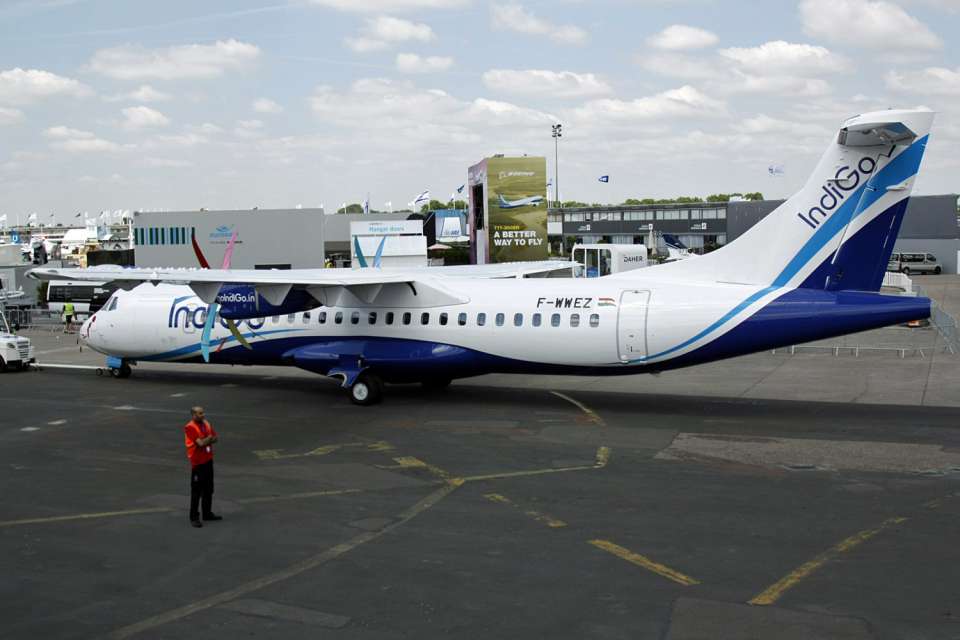Aerospace
IndiGo to buy 50 ATR planes; eyes regional aviation market

Airline major IndiGo is all set to introduce 50 turboprop planes to its fleet in a bid to increase more regional operations. InterGlobe Aviation, which runs IndiGo, informed the Bombay Stock Exchange on Tuesday that the company has signed a deal with French aircraft manufacturer Avions de Transport Regional GIE for buying 50 ATR 72-600 aircraft.
Introduction of the aircraft will help IndiGo increase its regional presence by starting more services connecting smaller towns in the country. Indigo aims to start turboprop operations in the third quarter of this financial year. In a period of two years, the company will induct 20 such aircraft to its fleet.
Currently, Indigo has a marketshare of close to 40 percent in the Indian domestic aviation sector and operates 133 Airbus A320 planes connecting 46 destinations.
“IndiGo is likely to be a 177 aircraft airline by March. We are looking to build a nation-wide regional network and connect cities that have not benefitted the aviation sector growth in India,” IndiGo president Aditya Ghosh said in the statement.
Indigo has reported a profit of Rs 1,659 crore for 2016-17 from Rs 1,986 crore in the previous year. Total revenue rose to Rs 19,369.57 crore for year ended 31 March compared to Rs 16,655.03 crore the year before. It also announced a divided of Rs 34 per share. Shares of InterGlobe rose almost 2% to close the day at Rs 1141.1 on Tuesday on BSE.

Aerospace
Boeing Transfers Rocket Stage to NASA, Paving Way for Human Moon Mission

Boeing has achieved a significant milestone by providing NASA with the second core stage of the Space Launch System (SLS) rocket.
This crucial component, crafted at NASA’s Michoud Assembly Facility (MAF), is set to propel the Artemis II crew into lunar orbit, marking humanity’s return to deep space after a 50-year hiatus.
The monumental Boeing-built rocket stage, the largest element of the Artemis II mission, will embark on a journey aboard the Pegasus barge, traveling 900 miles to NASA’s Kennedy Space Center.
Comparison of two legendary aircraft B777x vs B747 aircraft:Click here
Upon arrival, it will be meticulously integrated with other essential Artemis II components, including the upper stage, solid rocket boosters, and NASA’s Orion spacecraft within the iconic Vehicle Assembly Building. This intricate integration process is a vital step toward the eagerly anticipated Artemis II launch, slated for 2025.
“Boeing-built products helped land humankind on the moon in 1969, and we’re proud to continue that legacy through the Artemis generation,” remarked Dave Dutcher, vice president and program manager for Boeing’s SLS program. “Together, with NASA and our industry partners and suppliers, we are building the world’s most capable rocket and paving the way to deep space through America’s rocket factory in New Orleans.”
NASA, Lockheed Martin Reveal X-59 Quiet Supersonic Aircraft:Click here
The delivery of Core Stage 2 marks a significant achievement in the evolution of the SLS rocket. Towering over 200 feet and powered by four RS-25 engines, this core stage, coupled with two solid-fueled booster rockets, will generate a staggering 8.8 million pounds of thrust. This immense power is crucial to launching Artemis II and future missions into the vast expanse of space.
The SLS rocket stands unparalleled in its capability to transport both crew and substantial cargo to the moon and beyond in a single launch. Its extraordinary capacity will facilitate the delivery of human-rated spacecraft, habitats, and scientific missions to destinations including the moon and Mars, ushering in a new era of space exploration.
-

 Travel1 week ago
Travel1 week agoAir India to Expand US Operations with Three New Routes After a Decade
-

 Travel2 weeks ago
Travel2 weeks agoWhy We Should Avoid These Stamps in a Passport
-

 Airlines1 month ago
Airlines1 month agoInvestigations Reveal Fake Chinese Titanium in Boeing and Airbus Jets
-

 Tech4 weeks ago
Tech4 weeks agoChina’s CATL Plans 1,800-Mile Electric Plane Launch by 2027
-

 Airport3 days ago
Airport3 days agoTop 10 Largest Airports in the World by Size
-

 Aerospace4 weeks ago
Aerospace4 weeks agoChina’s Fighter Jets Turn Wings into Autonomous Drones
-

 Airlines4 days ago
Airlines4 days agoAir India Rolls Out A350s for Delhi-New York JFK and Newark Routes
-

 Defence3 weeks ago
Defence3 weeks agoBoeing Enhances Chinook with New Engines and Block II Upgrades at $96 Million







